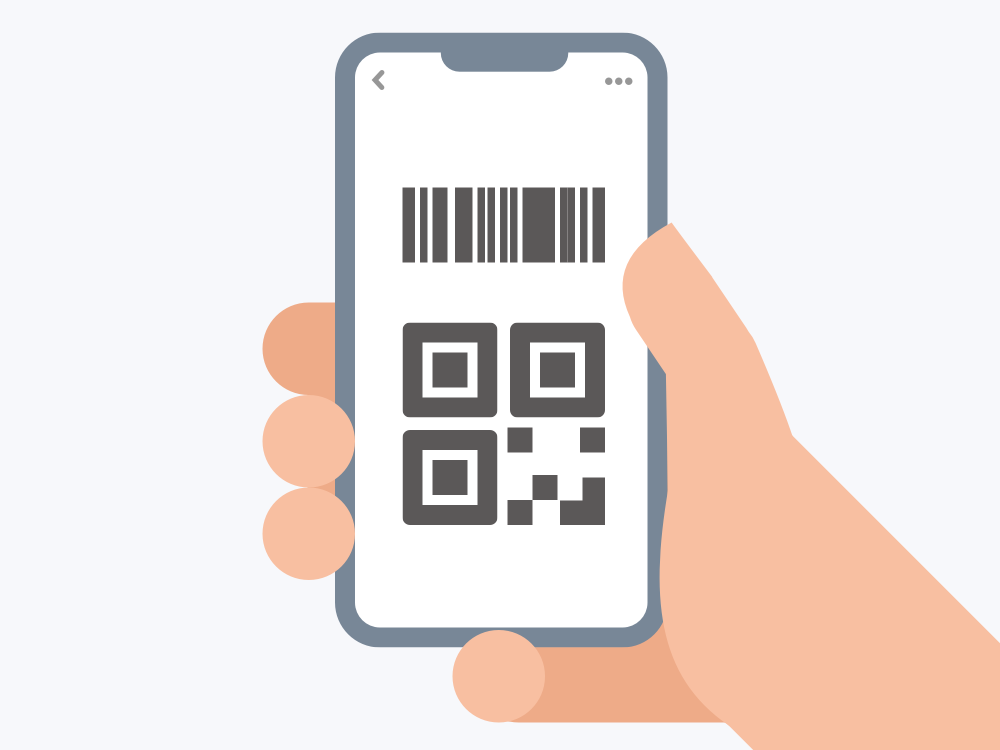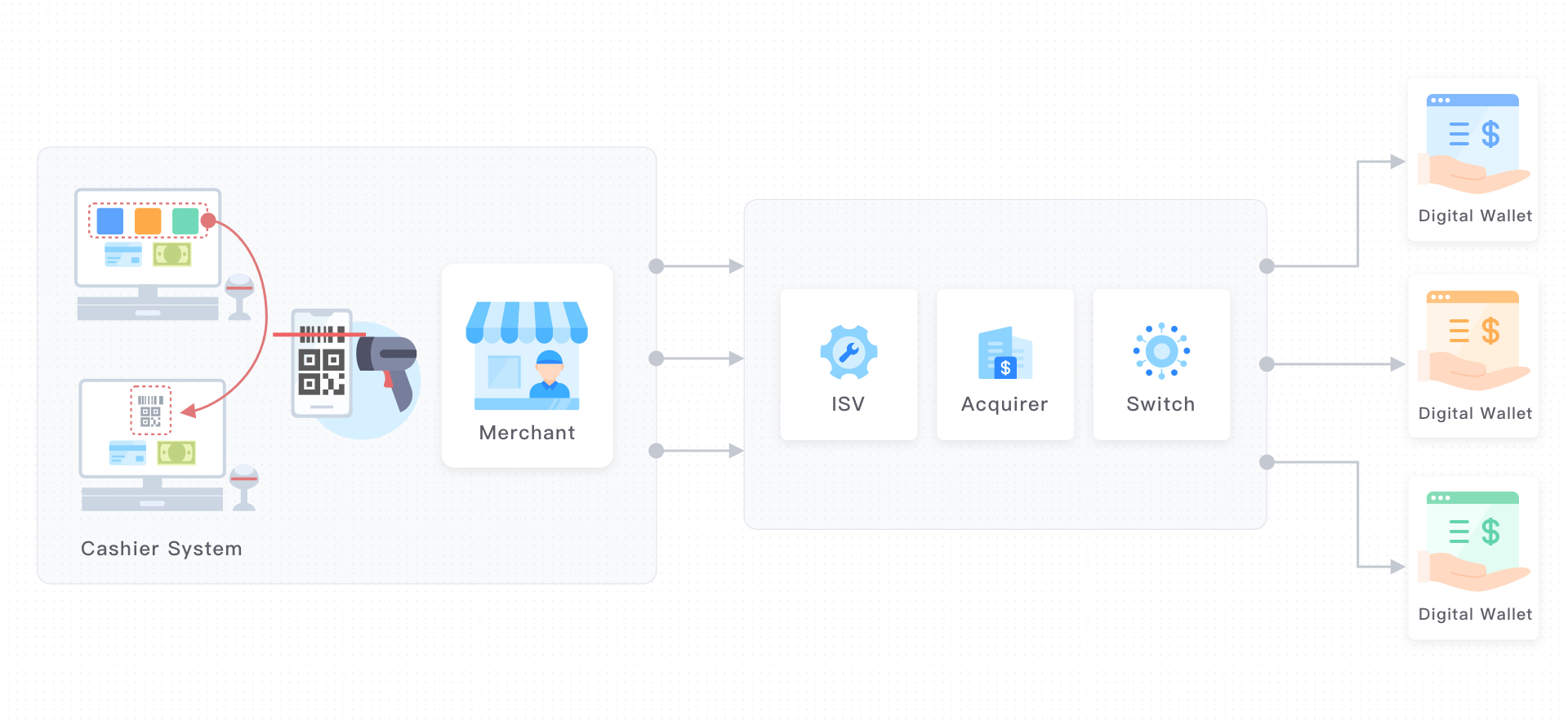Consumer-Presented Mode
QR code and barcode are ISO-compliant encoding and visualization of data. This standard covers the QR codes and barcodes used in the consumer-presented mode (CPM) for payments in brick-and-mortar stores. In this mode, QR code or barcode are presented by consumers (users) on their mobile devices for merchants to scan with scanning devices.
You can see a detailed analysis of the pain points of the existing consumer-presented mode for various roles. You can also see the benefits of a standardized consumer-presented mode. In addition, you can get started with the details of the standards.
User experience




Figure 1 User experience of consumer-presented mode
This diagram illustrates how payment is completed in the consumer-presented mode.
- At the cashier, a merchant specifies the transaction amount and confirms the code-scanning payment method with a consumer.
- The consumer opens his/her e-wallet app and presents the payment code to the merchant.
- The merchant uses a barcode/QR code identification device, such as a code scanner, to scan the code.
- Payment is then completed automatically.
Pain points
Without a standard, consumer-presented codes are formatted by Digital Wallet with different rules, which brings pain points for various roles involved in the process, including merchants, their acquirers, ISV, switches, as well as users and their Digital Wallets.
For merchants

Figure 2.1 Pain points for merchants in the consumer-presented mode
Merchants are faced with the following pain points, when the consumer-presented code formats of the mobile payments they accept are in conflict with each other:
- No common code parsing rules
- At the cashier, consumer-presented codes cannot be recognized by code scanners when the code length exceed the limit in the acquiring systems.
- When merchants upgrade their acquiring systems, there is no common code parsing rules to refer to.
- Time-consuming checkout
- Merchant cashiers are faced with too many interactions in the system; they have to manually select an Digital Wallet from a list of Digital Wallets. This leads to a time-consuming checkout, which also increases the risks of routing errors, transaction failures and fund losses.
- High integration cost
Heavy investment on system development and maintenance to accept payments from new Digital Wallets; for example, every time when there is a new Digital Wallet, merchants need to upgrade their systems and manually build an entrance to integrate with the new Digital Wallet.
For acquirers, ISVs and switches

Figure 2.2 Pain points for acquirers, ISV, and switches in the consumer-presented mode
The intermediaries, such as ISVs, acquirers and switches, who help merchants to integrate the acquiring systems with Digital Wallets, are faced with the following pain points:
- No common parsing rules
- Not sure about the code length range, especially the maximum length;
- Code parsing rules from different Digital Wallets might lead to routing conflicts.
- High investment cost
- Heavy investment on system development to support different code lengths;
- Continuous development to support different code parsing rules.
For digital wallets and consumers

Figure 2.3 Pain points for Digital Wallets and consumers in the consumer-presented mode
For Digital Wallets, especially for those with cross-border transactions, a lack of standard on consumer-presented mode of payments brings troubles:
- No common code issuing rules
- Not clear about whether their code formats are in conflict with other formats.
- The code lengths, which are designed independently by each Digital Wallet, may exceed the limits in the system.
- Cross-border transactions
Cross-border CPM transactions are not supported by merchants whose systems are designed for domestic Digital Wallets only. In this case, Digital Wallets have to provide users with the code-switching functionality in different countries/regions, which means users have to manually switch the consumer-presented codes according to different locations. This brings bad user experience and increases the risks of routing errors, transaction failures and fund losses.
Benefits
With the standard, a unified code issuing rule is available for Digital Wallets. The standardized consumer-presented codes can easily be supported across acceptance markets; merchants and acquirers can then quickly accept payments from new Digital Wallets; consumers can also benefit from a consistent user experience.
To be specific, these roles can enjoy the following benefits:
For merchants

Figure 2.4 Benefits for merchants in the consumer-presented mode
- Flexible
With a one-time development, merchants can have the flexibility to accept CPM payments from all the code issuers (Digital Wallets) who follow this standard.
- Fast and efficient
With a unified entrance to the cashier system, merchant cashiers can easily accept mobile payments effectively and efficiently.
For acquirers, ISVs and switches

Figure 2.5 Benefits for acquirers, ISV, and switches in the consumer-presented mode
- Cost-efficient
With a dynamic routing table, ISVs, acquirers, and switches can follow the rule to avoid code conflicts; they can also help merchants to have the flexibility to accept CPM payments from all the code issuer (Digital Wallets) who follow this standard.
- Configurable
As the standard is gradually adopted by various Digital Wallets, code issuing rules of each new Digital Wallet are continuously added to the routing table. Based on the latest routing table, ISVs, acquirers, and switches can quickly support the Digital Wallets with a low cost by configuring the routing rules.
For digital wallets and consumers

Figure 2.6 Benefits for Digital Wallets and consumers in the consumer-presented mode
- Convenient
Two options are available: Digital Wallets can either apply for new code issuer IDs to be added to the routing table, or register their existing code issuing rules to the routing table.
- Wider acceptance
With a unified code issuing rule, consumer-presented codes issued by Digital Wallets can be recognized and processed by merchants in the acceptance market where the standard is implemented.
- Consistent and user-friendly
Consumers can also benefit from a consistent user experience with a unified code format that is adopted worldwide.
Working with consumer-presented codes
The following detailed information is available for you to implement the consumer-presented mode:
You can find what a code is composed of and the combination rules of a code format.
You can check the code issuer according to the table. You can also see the determination process. In addition, you can contact us to get the lastest table.
You can see code samples to quickly get started.
You can see the roles and their interaction process in transaction processing of consumer-presented codes.
Security guidelines
Security guidelines for consumer-presented mode consist of the following topics:
- Security threats analysis in the end-to-end payment process and guidelines to mitigate these threats
- Guidelines for business security in this process
- General guidelines, requirements and recommendations
User experience design guidelines
You can refer to the user experience guidelines to design consumer-presented codes.
More information
Note that "QR Code" is a registered trademark of DENSO WAVE.
